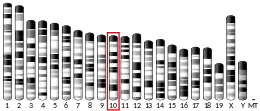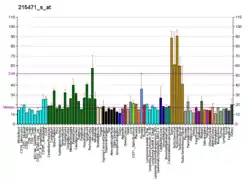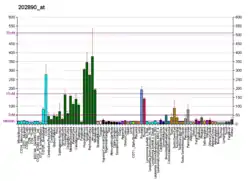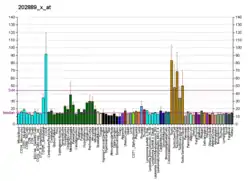MAP7
Ensconsin is a protein that in humans is encoded by the MAP7 gene.[5][6]
Function
The product of this gene is a microtubule-associated protein that is predominantly expressed in cells of epithelial origin. Microtubule-associated proteins are thought to be involved in microtubule dynamics, which is essential for cell polarization and differentiation. This protein has been shown to be able to stabilize microtubules, and may serve to modulate microtubule functions. Studies of the related mouse protein also suggested an essential role in microtubule function required for spermatogenesis.[6]
References
- GRCh38: Ensembl release 89: ENSG00000135525 - Ensembl, May 2017
- GRCm38: Ensembl release 89: ENSMUSG00000019996 - Ensembl, May 2017
- "Human PubMed Reference:". National Center for Biotechnology Information, U.S. National Library of Medicine.
- "Mouse PubMed Reference:". National Center for Biotechnology Information, U.S. National Library of Medicine.
- Masson D, Kreis TE (Nov 1993). "Identification and molecular characterization of E-MAP-115, a novel microtubule-associated protein predominantly expressed in epithelial cells". J Cell Biol. 123 (2): 357–71. doi:10.1083/jcb.123.2.357. PMC 2119845. PMID 8408219.
- "Entrez Gene: MAP7 microtubule-associated protein 7".
- Suzuki M, Hirao A, Mizuno A (December 2003). "Microtubule-associated [corrected] protein 7 increases the membrane expression of transient receptor potential vanilloid 4 (TRPV4)". J. Biol. Chem. 278 (51): 51448–53. doi:10.1074/jbc.M308212200. PMID 14517216.
Further reading
- Masson D, Kreis TE (1996). "Binding of E-MAP-115 to microtubules is regulated by cell cycle-dependent phosphorylation". J. Cell Biol. 131 (4): 1015–24. doi:10.1083/jcb.131.4.1015. PMC 2200015. PMID 7490279.
- Fabre-Jonca N, Viard I, French LE, Masson D (1999). "Upregulation and redistribution of E-MAP-115 (epithelial microtubule-associated protein of 115 kDa) in terminally differentiating keratinocytes is coincident with the formation of intercellular contacts". J. Invest. Dermatol. 112 (2): 216–25. doi:10.1046/j.1523-1747.1999.00500.x. PMID 9989799.
- Bulinski JC, Odde DJ, Howell BJ, Salmon TD, Waterman-Storer CM (2002). "Rapid dynamics of the microtubule binding of ensconsin in vivo". J. Cell Sci. 114 (Pt 21): 3885–97. PMID 11719555.
- Penttilä TL, Parvinen M, Paranko J (2004). "Microtubule-associated epithelial protein E-MAP-115 is localized in the spermatid manchette". Int. J. Androl. 26 (3): 166–74. doi:10.1046/j.1365-2605.2003.00406.x. PMID 12755995.
- Vanier MT, Deck P, Stutzmann J, Gendry P, Arnold C, Dirrig-Grosch S, Kedinger M, Launay JF (2004). "Expression and distribution of distinct variants of E-MAP-115 during proliferation and differentiation of human intestinal epithelial cells". Cell Motil. Cytoskeleton. 55 (4): 221–31. doi:10.1002/cm.10124. PMID 12845596.
- Suzuki M, Hirao A, Mizuno A (2004). "Microtubule-associated [corrected] protein 7 increases the membrane expression of transient receptor potential vanilloid 4 (TRPV4)". J. Biol. Chem. 278 (51): 51448–53. doi:10.1074/jbc.M308212200. PMID 14517216.
- Sood R, Bader PI, Speer MC, Edwards YH, Eddings EM, Blair RT, Hu P, Faruque MU, Robbins CM, Zhang H, Leuders J, Morrison K, Thompson D, Schwartzberg PL, Meltzer PS, Trent JM (2004). "Cloning and characterization of an inversion breakpoint at 6q23.3 suggests a role for Map7 in sacral dysgenesis". Cytogenet. Genome Res. 106 (1): 61–7. doi:10.1159/000078563. PMID 15218243. S2CID 39067023.
- Nousiainen M, Silljé HH, Sauer G, Nigg EA, Körner R (2006). "Phosphoproteome analysis of the human mitotic spindle". Proc. Natl. Acad. Sci. U.S.A. 103 (14): 5391–6. Bibcode:2006PNAS..103.5391N. doi:10.1073/pnas.0507066103. PMC 1459365. PMID 16565220.
- Beausoleil SA, Villén J, Gerber SA, Rush J, Gygi SP (2006). "A probability-based approach for high-throughput protein phosphorylation analysis and site localization". Nat. Biotechnol. 24 (10): 1285–92. doi:10.1038/nbt1240. PMID 16964243. S2CID 14294292.
- Olsen JV, Blagoev B, Gnad F, Macek B, Kumar C, Mortensen P, Mann M (2006). "Global, in vivo, and site-specific phosphorylation dynamics in signaling networks". Cell. 127 (3): 635–48. doi:10.1016/j.cell.2006.09.026. PMID 17081983. S2CID 7827573.
This article is issued from Wikipedia. The text is licensed under Creative Commons - Attribution - Sharealike. Additional terms may apply for the media files.






